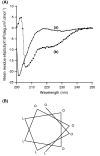Antimicrobial activity and membrane selective interactions of a synthetic lipopeptide MSI-843
- PMID: 15904663
- PMCID: PMC1550341
- DOI: 10.1016/j.bbamem.2005.02.010
Antimicrobial activity and membrane selective interactions of a synthetic lipopeptide MSI-843
Abstract
Lipopeptide MSI-843 consisting of the nonstandard amino acid ornithine (Oct-OOLLOOLOOL-NH2) was designed with an objective towards generating non-lytic short antimicrobial peptides, which can have significant pharmaceutical applications. Octanoic acid was coupled to the N-terminus of the peptide to increase the overall hydrophobicity of the peptide. MSI-843 shows activity against bacteria and fungi at micromolar concentrations. It permeabilizes the outer membrane of Gram-negative bacterium and a model membrane mimicking bacterial inner membrane. Circular dichroism investigations demonstrate that the peptide adopts alpha-helical conformation upon binding to lipid membranes. Isothermal titration calorimetry studies suggest that the peptide binding to membranes results in exothermic heat of reaction, which arises from helix formation and membrane insertion of the peptide. 2H NMR of deuterated-POPC multilamellar vesicles shows the peptide-induced disorder in the hydrophobic core of bilayers. 31P NMR data indicate changes in the lipid head group orientation of POPC, POPG and Escherichia colitotal lipid bilayers upon peptide binding. Results from 31P NMR and dye leakage experiments suggest that the peptide selectively interacts with anionic bilayers at low concentrations (up to 5 mol%). Differential scanning calorimetry experiments on DiPOPE bilayers and 31P NMR data from E.coli total lipid multilamellar vesicles indicate that MSI-843 increases the fluid lamellar to inverted hexagonal phase transition temperature of bilayers by inducing positive curvature strain. Combination of all these data suggests the formation of a lipid-peptide complex resulting in a transient pore as a plausible mechanism for the membrane permeabilization and antimicrobial activity of the lipopeptide MSI-843.
Figures








Similar articles
-
Solid-state NMR investigation of the membrane-disrupting mechanism of antimicrobial peptides MSI-78 and MSI-594 derived from magainin 2 and melittin.Biophys J. 2006 Jul 1;91(1):206-16. doi: 10.1529/biophysj.105.073890. Epub 2006 Apr 7. Biophys J. 2006. PMID: 16603496 Free PMC article.
-
Limiting an antimicrobial peptide to the lipid-water interface enhances its bacterial membrane selectivity: a case study of MSI-367.Biochemistry. 2010 Dec 21;49(50):10595-605. doi: 10.1021/bi101394r. Epub 2010 Nov 23. Biochemistry. 2010. PMID: 21062093 Free PMC article.
-
Mechanism of antibacterial action of dermaseptin B2: interplay between helix-hinge-helix structure and membrane curvature strain.Biochemistry. 2009 Jan 20;48(2):313-27. doi: 10.1021/bi802025a. Biochemistry. 2009. PMID: 19113844
-
Biological activity and structural aspects of PGLa interaction with membrane mimetic systems.Biochim Biophys Acta. 2009 Aug;1788(8):1656-66. doi: 10.1016/j.bbamem.2009.05.012. Epub 2009 May 29. Biochim Biophys Acta. 2009. PMID: 19481533 Review.
-
Lipid-induced conformation and lipid-binding properties of cytolytic and antimicrobial peptides: determination and biological specificity.Biochim Biophys Acta. 1999 Dec 15;1462(1-2):89-108. doi: 10.1016/s0005-2736(99)00202-3. Biochim Biophys Acta. 1999. PMID: 10590304 Review.
Cited by
-
Insights on the interactions of synthetic amphipathic peptides with model membranes as revealed by 31P and 2H solid-state NMR and infrared spectroscopies.Biophys J. 2006 Jun 1;90(11):4071-84. doi: 10.1529/biophysj.105.077339. Epub 2006 Mar 13. Biophys J. 2006. PMID: 16533836 Free PMC article.
-
Structure, membrane orientation, mechanism, and function of pexiganan--a highly potent antimicrobial peptide designed from magainin.Biochim Biophys Acta. 2009 Aug;1788(8):1680-6. doi: 10.1016/j.bbamem.2008.10.009. Epub 2008 Oct 29. Biochim Biophys Acta. 2009. PMID: 19010301 Free PMC article. Review.
-
Interaction of alamethicin with ether-linked phospholipid bilayers: oriented circular dichroism, 31P solid-state NMR, and differential scanning calorimetry studies.Biophys J. 2005 Oct;89(4):2434-42. doi: 10.1529/biophysj.105.067678. Epub 2005 Jul 29. Biophys J. 2005. PMID: 16055546 Free PMC article.
-
Biophysical approaches for exploring lipopeptide-lipid interactions.Biochimie. 2020 Mar;170:173-202. doi: 10.1016/j.biochi.2020.01.009. Epub 2020 Jan 21. Biochimie. 2020. PMID: 31978418 Free PMC article. Review.
-
In Silico Discovery of Novel Ligands for Antimicrobial Lipopeptides for Computer-Aided Drug Design.Probiotics Antimicrob Proteins. 2018 Jun;10(2):129-141. doi: 10.1007/s12602-017-9356-9. Probiotics Antimicrob Proteins. 2018. PMID: 29218506 Review.
References
-
- Zasloff M. Antimicrobial peptides of multi-cellular organisms. Nature. 2002;415:389–395. - PubMed
-
- Devine DA, Hancock REW. Cationic peptides: distribution and mechanisms of resistance. Curr. Pharm. Des. 2002;8:703–714. - PubMed
-
- Maloy WL, Kari UP. Structure–activity studies on magainins and other host defense peptides. Biopolymers. 1995;37:105–122. - PubMed
-
- Matsuzaki K. Why and how are peptide–lipid interactions utilized for self-defense? Magainins and tachyplesins as archetypes. Biochim. Biophys. Acta. 1999;1462:1–10. - PubMed
-
- Shai Y. From innate immunity to de-novo designed antimicrobial peptides. Curr. Pharm. Des. 2002;8:715–725. - PubMed
Publication types
MeSH terms
Substances
Grants and funding
LinkOut - more resources
Full Text Sources
Other Literature Sources
Medical

